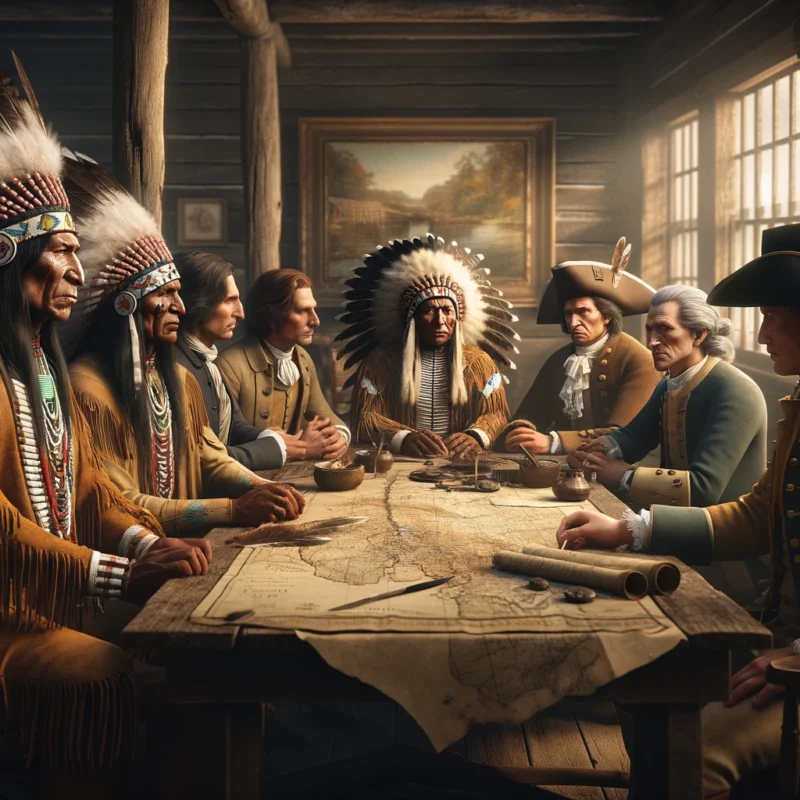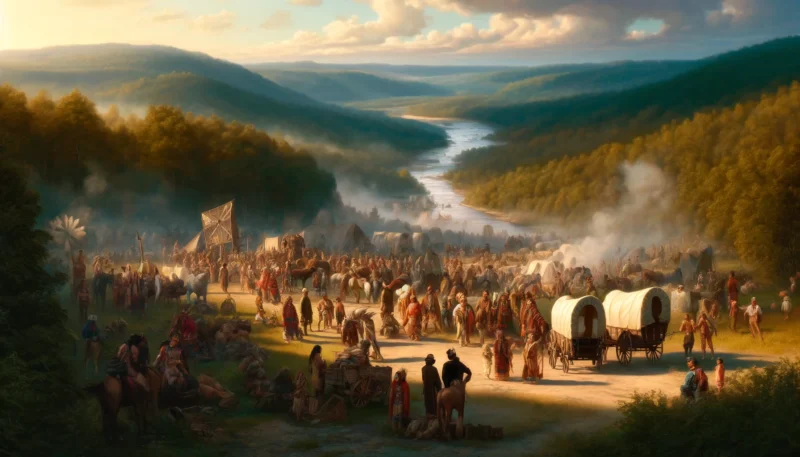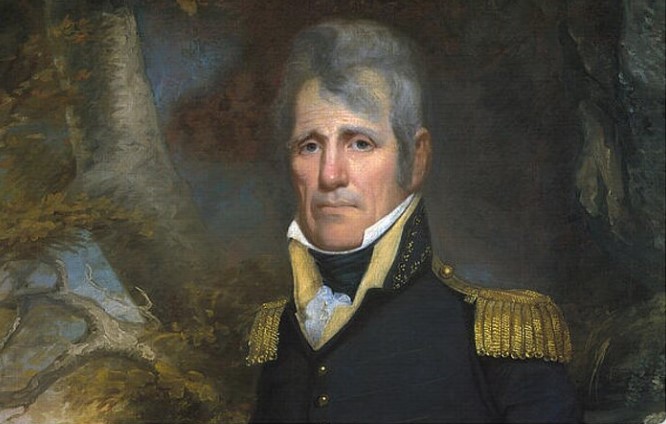The Battle of Horseshoe Bend, fought on March 27, 1814, was a pivotal conflict between the United States forces and the Creek Nation, part of the larger Creek War.
The battle marked a significant turning point in the U.S. efforts to expand its territory in the Southeast.
Simultaneously, the Cherokee Removal, which culminated in the Trail of Tears, represents a tragic chapter in American history where thousands of Cherokee people were forcibly relocated from their ancestral lands.
Let’s see how it went.
The Battle of Horseshoe Bend
The Battle of Horseshoe Bend, which occurred on March 27, 1814, was a decisive engagement in the Creek War, part of the broader conflict known as the War of 1812.
Major General Andrew Jackson led a force of approximately 3,300 soldiers, including:
- Militia
- Regular army
- Allied Native American warriors
They marched against the Red Stick Creeks, a faction of the Creek Nation opposed to American expansion. Chief Menawa led the Red Stick Creeks, who had fortified their position at Horseshoe Bend on the Tallapoosa River.
The battle was fiercely contested, with Jackson’s forces employing a combination of artillery bombardment and infantry assaults to breach the Creek defenses.
The Creek warriors fought tenaciously but were ultimately overwhelmed. The battle resulted in a significant loss of life for the Creeks, with estimates of around 800 Red Stick warriors killed.
The outcome of the Battle of Horseshoe Bend was significant for several reasons. It effectively ended organized Creek resistance against the United States in the Southeast, leading to the Treaty of Fort Jackson.
Under the terms of this treaty, the Creeks ceded more than 21 million acres of land to the U.S. government, covering much of present-day Alabama and Georgia.
Immediate Consequences of the Battle

The immediate aftermath of the Battle of Horseshoe Bend had profound implications for Native American territories in the Southeast.
The Treaty of Fort Jackson, signed in August 1814, compelled the Creeks to cede vast tracts of land to the United States. The land cession significantly altered the landscape of Native American territories, displacing numerous Creek communities and opening up the region for American settlers and agricultural development.
One of the notable aspects of the Battle of Horseshoe Bend was the involvement of the Cherokee Nation.
Many Cherokee warriors, seeing an opportunity to align themselves with the U.S. forces, participated in the battle against their traditional rivals, the Creeks.
The alignment of the Cherokee with U.S. forces in the Battle of Horseshoe Bend tells the story of the complexities of Native American alliances and the shifting dynamics of power in the region.
While the immediate consequence for the Creeks was the loss of their territory and a devastating blow to their military strength, the Cherokee initially benefited from their cooperation with the United States.
However, this alignment also foreshadowed future conflicts and challenges that the Cherokee would face as American expansion continued.
The Role of Andrew Jackson
Andrew Jackson’s role in the Battle of Horseshoe Bend and subsequent events was pivotal in shaping U.S. policies toward Native Americans.
Jackson’s military success at Horseshoe Bend propelled him to national prominence, establishing his reputation as a formidable leader.
Jackson’s views on Native Americans were shaped by his frontier experiences and belief in American expansionism.
He saw Native American tribes as obstacles to progress and was a staunch advocate for their removal from ancestral lands to make way for American settlers.
As President, Jackson implemented a series of policies that culminated in the Indian Removal Act of 1830.
Jackson’s justification for this policy was rooted in a paternalistic view that removal was necessary for the survival of Native American cultures, though the reality was that it facilitated Am erican expansion and economic growth at the expense of indigenous peoples.
Hisrole in the implementation of Indian removal policies had devastating consequences for Native American communities, including the Cherokee.
His administration’s enforcement of the Indian Removal Act led to widespread displacement, suffering, and death among Native American tribes.
The legacy of Jackson’s policies is a contentious and deeply painful chapter in American history, illustrating the complex interplay between:
- Military conquest
- Political power
- The human cost of expansionism
Cherokee Leadership and Diplomacy

Cherokee leadership during the early 19th century was marked by figures such as John Ross and Major Ridge, who played crucial roles in negotiating with the United States government.
John Ross, born to a Scottish father and a Cherokee mother, rose to prominence as a skilled diplomat and leader of the Cherokee Nation.
His mixed heritage and education enabled him to navigate both Cherokee and American political landscapes effectively.
Ross and Major Ridge recognized the threats of American expansion and sought to protect Cherokee interests through legal and diplomatic means.
They advocated for adopting European-American customs and legal systems, believing that demonstrating assimilation would help secure their people’s land and sovereignty.
Under their leadership, the Cherokee Nation adopted a written constitution modeled after the U.S. Constitution, established a capital at New Echota, and promoted education and literacy among their people. Despite these efforts, Ross and Ridge faced immense pressure from the U.S. government and encroaching settlers.
Their diplomatic strategies included negotiating treaties and seeking legal recourse to defend Cherokee land rights.
The most notable of these legal battles was Worcester v. Georgia (1832), in which the U.S. Supreme Court ruled in favor of the Cherokee, affirming their sovereignty.
President Jackson’s refusal to enforce the Court’s decision highlighted the limitations of legal victories in the face of political and military power.
The Influence of the Battle on Cherokee Policy
The defeat of the Creeks at the Battle of Horseshoe Bend had far-reaching implications for U.S. policy towards all Native Americans, including the Cherokee.
The decisive victory demonstrated the military might of the United States and reinforced the belief that Native American resistance could be crushed through force. The outcome emboldened U.S. policymakers to pursue more aggressive strategies for dealing with indigenous peoples.
One of the most significant policy shifts influenced by the battle was the Indian Removal Act of 1830, championed by Andrew Jackson. The Act mandated the relocation of Native American tribes living east of the Mississippi River to lands west of the river.
Jackson’s justification for the removal was framed as a benevolent effort to protect Native American cultures from extinction due to encroaching settlers. The Creek defeat also served as a warning to other tribes about the futility of armed resistance against the U.S. military.
For the Cherokee, the lesson was clear: to avoid a similar fate, they would need to employ different strategies. While some Cherokee leaders, like Major Ridge, initially believed that cooperation and assimilation might protect their interests, the growing pressure from the U.S. government forced a reevaluation of their approach.
The Battle of Horseshoe Bend, therefore, influenced U.S. policies and Native American strategies, illustrating the broader context of conflict and negotiation that defined this era of American history.
VII. The Treaty of New Echota and Cherokee Removal

The Treaty of New Echota, signed in 1835, was one of the most controversial treaties in American history, leading directly to the forced removal of the Cherokee people.
The treaty was negotiated by a small faction of the Cherokee Nation, led by Major Ridge, his son John Ridge, and Elias Boudinot, without the authorization of Principal Chief John Ross or the majority of the Cherokee people.
The Treaty of New Echota ceded all Cherokee lands east of the Mississippi River to the United States in exchange for land in present-day Oklahoma and monetary compensation. The treaty’s terms were highly favorable to the U.S. government and devastating for the Cherokee.
Despite widespread opposition within the Cherokee Nation, the U.S. Senate ratified the treaty in 1836 by a single vote. The treaty caused deep divisions within the Cherokee Nation.
John Ross and the majority of the Cherokee people vehemently opposed the treaty, viewing it as illegitimate and unjust. Ross and his supporters petitioned the U.S. government to nullify the treaty, arguing that it was not representative of the will of the Cherokee Nation.
Their efforts were in vain, and the U.S. government proceeded with plans for removal. The implementation of the Treaty of New Echota led to the forced relocation known as the Trail of Tears.
Over 16,000 Cherokee were rounded up and marched westward under harsh conditions, resulting in the deaths of approximately 4,000 people due to various factors like:
- Disease
- Exposure
- Starvation
The Trail of Tears stands as a stark reminder of the human cost of policies driven by expansionist ambitions and racial prejudice.

